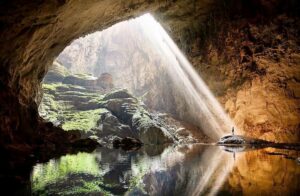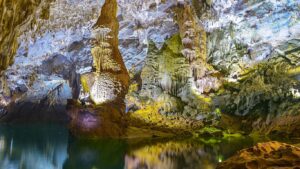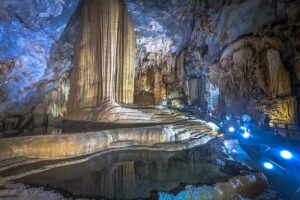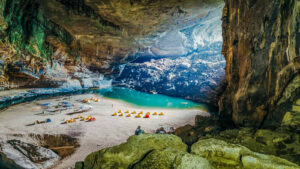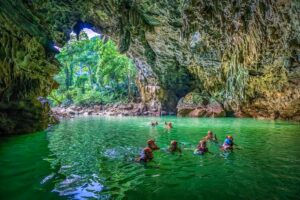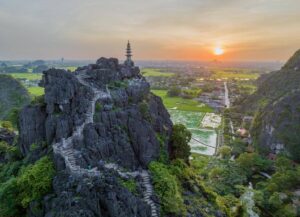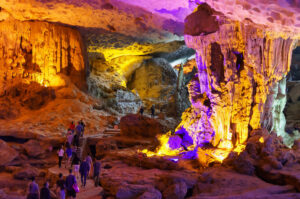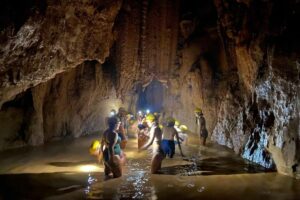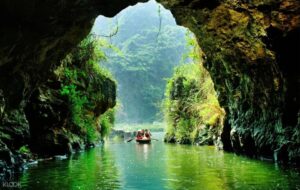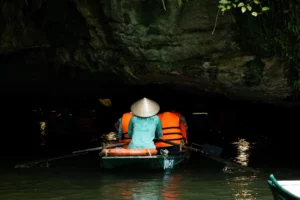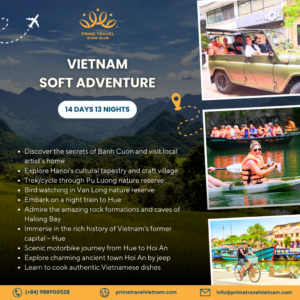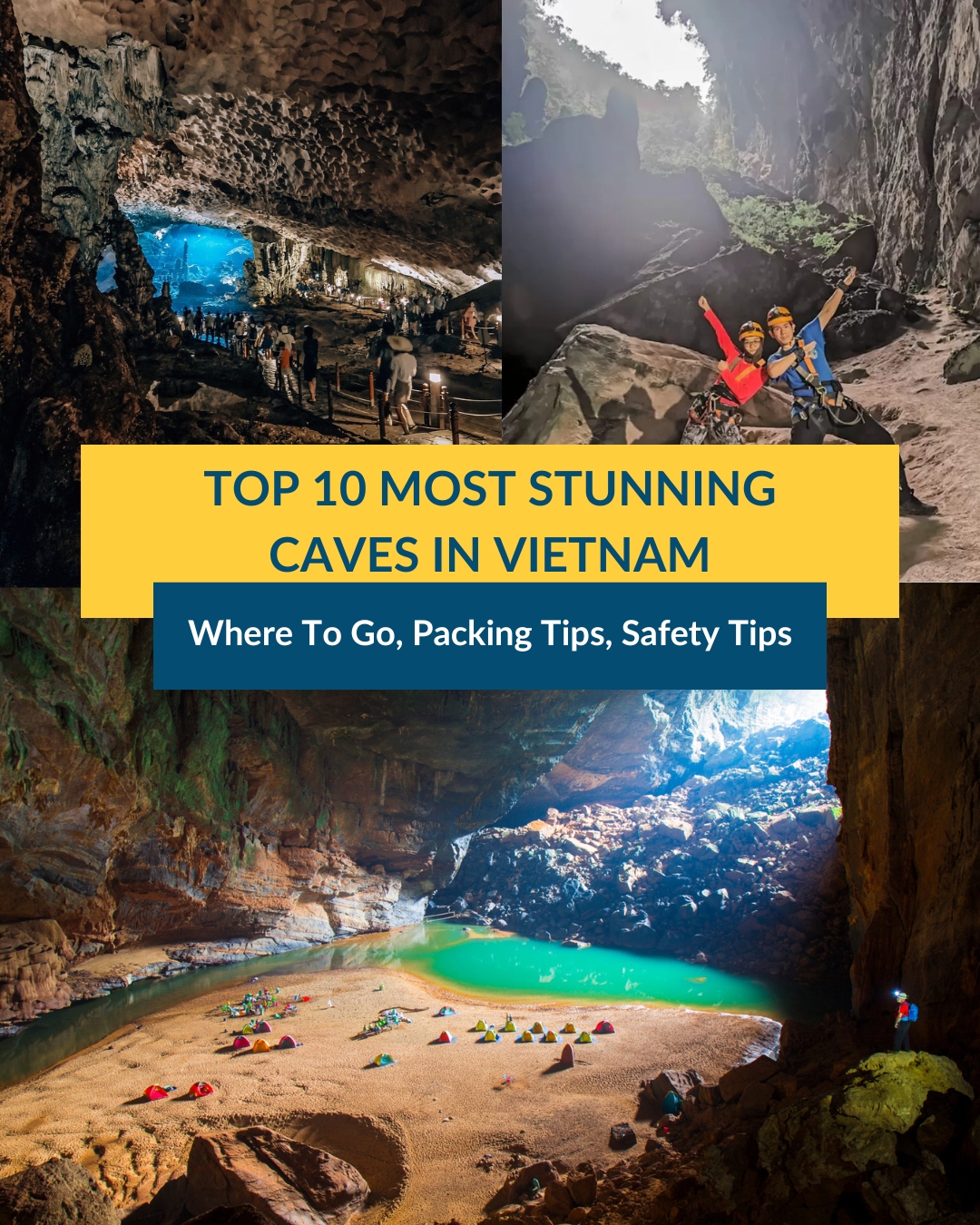
TOP 10 Most Stunning Caves in Vietnam You Need to See
Vietnam’s caves offer some of the most jaw-dropping natural wonders in Southeast Asia. From lush valleys to dramatic karst mountains, the country is filled with underground worlds waiting to be explored.
Whether you’re an adventure lover seeking massive chambers or a relaxed traveler looking for scenic boat rides through river caves, Vietnam has it all. The diversity of cave experiences here is unmatched.
With an amazing blend of natural beauty, compelling history, and adventurous experience, Vietnam’s cave systems are a must-do in your Vietnam itinerary.
In this guide, Prime Travel will show you the 10 most stunning caves in Vietnam that you shouldn’t miss. Moreover, we also share all the information you need to explore these most beautiful caves in Vietnam.
Best Caves in Vietnam for Nature Lovers
Son Doong Cave
Located in Phong Nha-Ke Bang National Park in Quang Binh Province, Son Doong Cave is the largest cave in the world. This extraordinary natural wonder is well-known for its vast, enormous underground chambers and rivers. It was formed along a fault line in Asia’s oldest karst mountain range, dating back around 400 to 450 million years.
Discovered by a local man in 1990, and then lost the exact location of it. After that, this local man officially explored with British caver Howard Limbert and his team in 2009, and it has since become a bucket-list destination for adventure travelers worldwide.
Son Doong Cave stretches 9.4 kilometers and features massive chambers, some large enough to fit a 40-story skyscraper.
Inside, you’ll find a unique ecosystem, complete with its own jungle, weather system, and underground river. The cave also contains towering stalagmites, rare cave pearls, and sinkholes that allow sunlight to stream in, creating breathtaking views.
To preserve its fragile ecosystem, access to Son Doong is strictly controlled. Only one tour operator (Oxalis Adventure) is licensed to run tours here. You’ll need to book in advance for over a year and secure permits for the multi-day expedition, which involves trekking, climbing, and even swimming at times.
The best time to visit Son Doong is from January to August. During the rainy season (September to December), tours are suspended due to safety risks.
The tour is not cheap; it typically costs around $3,000–$3,500 USD per person, but the once-in-a-lifetime experience is well worth the price for many.
Phong Nha Cave
Phong Nha Cave is one of the most famous and accessible caves in Vietnam, located inside Phong Nha-Ke Bang National Park in Quang Binh Province. This UNESCO World Heritage site features a 7,729-meter-long cave system filled with underground rivers, rock formations, and fascinating legends.
Phong Nha Cave is divided into 3 main areas based on the light levels: the entrance area with bright light, the middle area with moderately lit light, and the dark area. Each zone offers distinct types of organisms adapted to those specific lighting conditions.
What makes Phong Nha special is its stunning stalactites, peaceful boat ride access, and its role as the entrance to deeper cave systems in the park. It’s less physically demanding than Son Doong or Hang En, making it a great choice for families and first-time explorers. The cave is often part of a half-day tour that includes a scenic boat trip along the Son River.
Phong Nha Cave is open year-round, but the best time to visit is between March and August, when the weather is dry and the water levels are safe for boating. No pass is needed, but an entrance fee is 250,000 VND per person.
If you’re wondering where to see incredible cave formations in Vietnam without extreme trekking, Phong Nha Cave is the perfect starting point. It’s one of the most beautiful and accessible caves in the country, ideal for travelers of all ages.
If you are interested in Vietnam’s nature & wildlife destinations, check out our blog post Top 10 Vietnam National Parks To Visit In 2025
Paradise Cave (Thien Duong)
Another stunning cave nestled in Phong Nha – Ke Bang National Park, Paradise Cave is often described as the most beautiful dry cave in Vietnam.
The cave dates back over 300 million years and stretches over 31 kilometers; it’s one of the longest dry caves in Asia, with towering stalactites and stalagmites that resemble natural sculptures. It also boasts the longest wooden bridge in Asia.
Although Paradise Cave is the longest dry cave in Asia, tourists are only allowed to explore 3.5 kilometers deep or 1-2 kilometers when the tide is high. The exploration features wooden walkways and lighting that highlight the cave’s stunning rock formations.
What makes Paradise Cave a favorite is its majestic scale and easy access. It’s only a one-kilometer walk via illuminated wooden stairs, suitable for travelers of all ages, and doesn’t require technical trekking skills.
The best time to visit Paradise Cave is from March to August, when the weather is dry and clear. Avoid the rainy season (September–November) as access may be limited due to flooding in the national park.
Entrance fees are around 250,000 VND (~10 USD) per person and tours usually start from around 2,500,00 VND (~95 USD). You’ll need to walk or take a golf cart for 1.5 kilometers to reach the entrance, then climb a set of stairs to get inside.
Hang En Cave
Hang En Cave is one of the largest caves in Vietnam and the third largest in the world. Located deep in the tropical forest of Phong Nha-Ke Bang National Park, this massive cave is a gateway for those heading to the legendary Son Doong. But it’s also a jaw-dropping destination in its own right.
Hang En Cave has 3 entrances, stretches more than 1.6 kilometers in length, and towers up to 120 meters high. To reach Hang En, visitors must join a guided trekking tour. The only licensed tour operator is Oxalis Adventure, and the price is $330 USD, not cheap at all, but you’ll be rewarded with the pristine beauty of this cave.
Inside the cave, you’ll find an enormous chamber with a natural sandy beach and even a campsite where you can spend the night. Waking up to birdsong and the sight of sunlight pouring through the cave’s entrance is a surreal experience. The cave is also home to thousands of swallows, which is how it got its name—”Hang En” means “Swallow Cave” in Vietnamese.
The best time to explore Hang En is during the dry season, from January to August. Tours are typically suspended during the rainy season due to flooding and trail conditions. Permits and experienced guides are required, but everything is usually arranged by tour companies based in Phong Nha.
Tu Lan Cave
First discovered by the British Cave Research Association in 1992, Tu Lan Cave System is a hidden paradise for adventure lovers, located about 70 kilometers from Phong Nha in Quang Binh Province.
This remote cave system consists of over 20 caves, both dry and wet, with stunning limestone formations, underground rivers, and jungle-clad landscapes. Boasting a pristine and wonderful beauty, it has since become a must-visit destination for caving and nature enthusiasts when it comes to exploring caves in Vietnam.
What makes Tu Lan unique is the variety of experiences it offers. Visitors can trek through dense tropical forest, swim through underground river passages, and camp in scenic valleys. Highlights from touring this cave include Hang Ken, famous for its towering stalactites, and Hang Tu Lan, which involves swimming into a cave mouth to reach hidden chambers.
Exploring Tu Lan requires a guided multi-day tour. These tours range from 1-day adventures to challenging 4-day expeditions. You’ll need a moderate level of fitness, as tours involve hiking, climbing, river crossings, and swimming. Safety gear, food, and accommodation (usually camping) are provided by licensed tour operators.
The best time to visit Tu Lan is between April and September, when the weather is warm, the jungle is lush, and swimming in the caves is ideal. Tours are closed during the rainy season (October to early November) due to high water levels. To protect the caves and visitors, only certified operators like Oxalis Adventure are allowed to run tours in this area.
Tu Lan is ideal for travelers who want a mix of physical challenge and breathtaking scenery. With crystal-clear streams, lush jungles, and dramatic karst formations, it’s one of the most rewarding cave systems to explore in Vietnam.
Read more>>>Vietnam Weather by Month: 12-Month Guide for Travelers’ Best Trip
Mua Cave
Tucked away in Northern Vietnam, just 1.5 hours’ drive from Hanoi, Mua Cave is located in Ninh Binh and is often known as “Ha Long Bay on land”. You can totally visit this place as a day trip from Hanoi with Prime Travel.
While the cave itself is small, what truly draws visitors is the panoramic view from the top of Hang Mua Peak. To reach it, you’ll climb nearly 500 stone steps carved into the limestone. At the summit, you’ll be rewarded with breathtaking views of the Tam Coc rice fields, winding rivers, and dramatic limestone karsts.
It’s especially magical in late May and early June when the rice fields turn golden yellow. The best time to visit is early morning or late afternoon, when the weather is cooler and the light is best for photos.
Entry to Mua Cave is about 100,000 VND (around $4 USD). Nearby, you’ll find cafes, lotus ponds, and cozy homestays, perfect for relaxing before or after your climb. If you’re planning a trip to Ninh Binh, Mua Cave is a must-see, offering stunning natural scenery and one of the finest panoramic views in Northern Vietnam.
If you are planning your trip to Ninh Binh, you should read our complete Ninh Binh guide.
Sung Sot Cave (Surprise Cave)
Sung Sot Cave, also known as Surprise Cave, is one of the most famous caves in Ha Long Bay. It was discovered by the French in 1901 and named for the astonishing formations inside.
Once inside, you’ll understand how it got its name. The cave features two massive chambers with towering ceilings, colorful stalactites, and dramatic rock shapes that resemble animals and mythical creatures.
Sung Sot Cave is a popular stop for a lot of Ha Long Bay overnight cruises. Therefore, this is, without a doubt, one of the busiest caves in this UNESCO World Heritage Site. You will follow a set route with a tour guide when you go into the cave, and it’s often packed with people.
Since tourists visiting this cave often take an overnight cruise tour in Ha Long Bay, the entrance fee is usually included in the price of your bay cruise, so you don’t need to worry about buying a ticket.
The best time to visit Sung Sot Cave aligns with the best time to visit Ha Long Bay. Spring or autumn is ideal to admire the beauty of this cave.
Dark Cave
Dark Cave, or Hang Tối, offers a thrilling cave adventure in Quang Binh Province. Located within the Phong Nha-Ke Bang National Park, this cave combines natural beauty with outdoor activities like ziplining, wading through mud-filled passages, or kayaking, making it a top choice for adventure seekers.
Unlike other caves with walkways and lighting, Dark Cave stays true to its name; there’s no artificial light inside. Visitors wear headlamps, walk barefoot, and swim across the river to reach the entrance, and then explore the dark, muddy tunnels.
The highlight? A natural mud bath deep inside the cave, where you can float effortlessly in thick, mineral-rich mud.
After exiting the cave, most tours include zip-lining, swimming in the Chay River, and kayaking, perfect for cooling off and adding to the fun. The Dark Cave is open from 8:00 AM to 6:00 PM, and the tour usually takes about 2 hours. Therefore, it’s best to plan your tour in the morning or early afternoon; you shouldn’t visit late in the afternoon.
On top of that, the best season to visit is during the dry season, ranging from February to August. There is an entrance fee of 450,000 VND. If you want to try the longest in Vietnam, you can also do it for 250,000 VND.
Read more>>>Ultimate Vietnam Summer Travel Guide 2025: Weather, Best Places & Insider Tips
Tam Coc Caves
Located in Ninh Binh Province, Tam Coc, meaning “Three Caves”, is often called the “Halong Bay on land.” This picturesque area features three natural limestone caves (Hang Ca, Hang Hai, and Hang Ba) formed by the Ngo Dong River flowing through mountains and rice paddies.
A boat trip is the only way to access the caves, and it’s part of what makes Tam Coc so special. Rowed by local women, often using their feet, these boats glide past golden rice fields (especially vibrant from late May to early June), towering cliffs, and through cool, shadowy cave tunnels.
The boat ride lasts shorter than Trang An, about 1.5–2 hours, passing through three caves and wide, open views of the countryside. Tickets cost around 150,000 VND per person, and you can find the pier in Tam Coc village.
Besides visiting Tam Coc Caves, bird-watching in Ninh Binh is also a favorite wildlife getaway from the city of Hanoi
Trang An Caves
One of the most iconic experiences in any Ninh Binh itinerary is a traditional rowboat ride through its peaceful river landscapes. Trang An Scenic Landscape Complex, a UNESCO World Heritage Site in Ninh Binh, is home to multiple cave passages, spiritual sites, and historical temples.
The cave system here includes highlights like Sang Cave, Toi Cave, Nau Ruou Cave, and more. Each cave reveals a different spectacle, stalactites sparkling above your head, echoing caverns, and narrow tunnels lit only by reflections from the water. Unlike Tam Coc, Trang An’s boat routes are longer, often passing through 8–9 caves and several temples in one tour.
The boat tour lasts approximately 3 hours and includes 2–3 stops for temple visits or short hikes. Ticket prices are around 250,000 VND for adults and 100,000 VND for children under 1.4 meters (about 4 ft 6).
At the entrance, you’ll have the option to choose from three main routes. While many opt for the shorter ones, we suggest Route 1 for its scenic beauty and tranquil temple visits.
Tips for Visiting Caves in Vietnam
Exploring caves in Vietnam is an unforgettable experience, but proper preparation can make your adventure safer and more enjoyable. From packing the right gear to choosing the best time to visit, these tips will help you get the most out of your cave tour.
What to Pack
Packing smart is essential for a safe and enjoyable cave tour in Vietnam. Most caves require walking, climbing, or even swimming, so here’s what you should bring when going on a cave adventure in Vietnam:
- Lightweight, Quick-Drying Clothing: Ideal for hot, humid conditions and activities that may involve water. Avoid cotton, as it takes longer to dry.
- Long Sleeves and Pants: Help protect your skin from sharp rocks, bugs, and sunburn.
- Warm Layers: Caves can be cool inside. Bring a fleece or light jacket, especially for multi-day adventures like Hang En or Tu Lan.
- Rain Jacket: A waterproof jacket is useful during Vietnam’s rainy season or sudden downpours.
- Hat and Sunglasses: Essential for sunny and harsh weather during the summer.
- Trekking Boots: Wear sturdy, non-slip hiking shoes with ankle support, especially for caves with rugged terrain.
- Water Shoes/Sandals: For caves with rivers or wet entrances, pack water shoes or sandals with strong grip.
- Backpack: Use a small daypack for essentials like snacks, water, and gear. If your journey is longer, opt for a durable, water-resistant backpack.
- Reusable Water Bottle: Stay hydrated throughout your cave exploration, especially in tropical heat.
- First Aid Kit: Include basics like plasters, antiseptic wipes, pain relievers, and any personal medication if needed.
- Insect Repellent: Vietnam’s tropical areas can have mosquitos, so keep repellent handy before and after cave visits.
Safety Tips
Cave exploration in Vietnam is an amazing experience, but safety should always come first. Whether you’re visiting large tourist caves or going on adventure treks, these tips will help keep you safe:
- Always go with a licensed guide: For caves like Son Doong, Tu Lan, or Hang En, a guided tour is mandatory. Local guides know the terrain and can respond quickly in case of emergencies. Don’t go exploring these caves by yourself.
- Check weather forecasts: Heavy rains can lead to flash floods or slippery trails. Avoid visiting caves during or after storms, especially in the rainy season.
- Wear the right gear: Helmets, headlamps, and non-slip footwear are essential for adventure caves. Even for tourist caves, sturdy shoes are a must.
- Stay with your group: Don’t wander off on your own. Caves can be dark and confusing, and it’s easy to get lost.
- Mind your footing: Wet or muddy cave floors can be very slippery. Walk slowly, use handrails when available, and avoid jumping over rocks.
- Hydrate and bring snacks: Many cave trips involve physical activity. Stay hydrated and bring energy bars for longer tours.
- Watch for wildlife: Caves are home to bats, insects, and sometimes snakes. Stay calm and follow your guide’s instructions if you encounter any animals.
Read more>>>Tips to travel Vietnam for senior travelers
FAQs About Cave Tours in Vietnam
Do I need a permit to visit caves like Son Doong or Hang En?
Yes. Visiting caves like Son Doong and Hang En requires a permit and booking through an authorized tour operator. These caves are located in protected areas, and tours are limited to preserve the ecosystem. Be sure to plan well in advance, especially for Son Doong, which has limited slots each year.
Are cave tours in Vietnam suitable for beginners or families with children?
Yes, many cave tours in Vietnam are beginner and family-friendly, like Phong Nha, Tam Coc, or Sung Sot Cave. These spots are easy to access and safe for kids. However, some adventure caves such as Hang En, Tu Lan, or Son Doong require trekking, swimming, and camping, making them more appropriate for experienced travelers in good physical shape.
Can I visit these caves year-round?
Not all caves are accessible all year. Some caves in Quang Binh Province like Tu Lan or Hang En are closed during the rainy season (typically September to November) for safety. The best time to visit most caves is from January to August, when weather conditions are dry and more stable.
Are guided tours required for all caves, or can I explore on my own?
Guided tours are required for most adventure caves, especially those in Phong Nha-Ke Bang National Park. For easier caves like Mua Cave or Tam Coc, you can explore independently. However, having a guide often enhances the experience, offering insights into geology, history, and local culture.
Is it safe to explore caves during the rainy season?
No, it’s not recommended. Caves can flood quickly during heavy rain, making conditions dangerous. Tour operators often suspend activities during this time. Always check weather forecasts and follow safety guidance from local experts.
Do I need to be physically fit to join a cave tour?
It depends on the cave. Tours to Son Doong, Tu Lan, and Hang En involve hiking, swimming, and climbing, so moderate to high fitness is essential. For more leisurely experiences, opt for caves with paved paths or boat access like Phong Nha or Trang An.
Highly recommend Vietnam tours in Summer
- 14-Day Cultural and Culinary Journey Through Vietnam
- 14-Day Vietnam Soft Adventure
- 10-Day Mekong Delta Cultural Experience from Vietnam to Cambodia
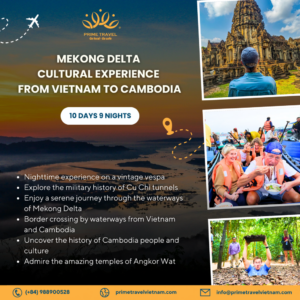
Essential Da Nang Guide and Itinerary: Best Things to Do for Travelers 2025
Visit Vietnam In July – Weather, Traditional Festival and Best Places To Visit 2025
Vietnam Tours From Australia: Best Tours And Holiday Packages 2025


